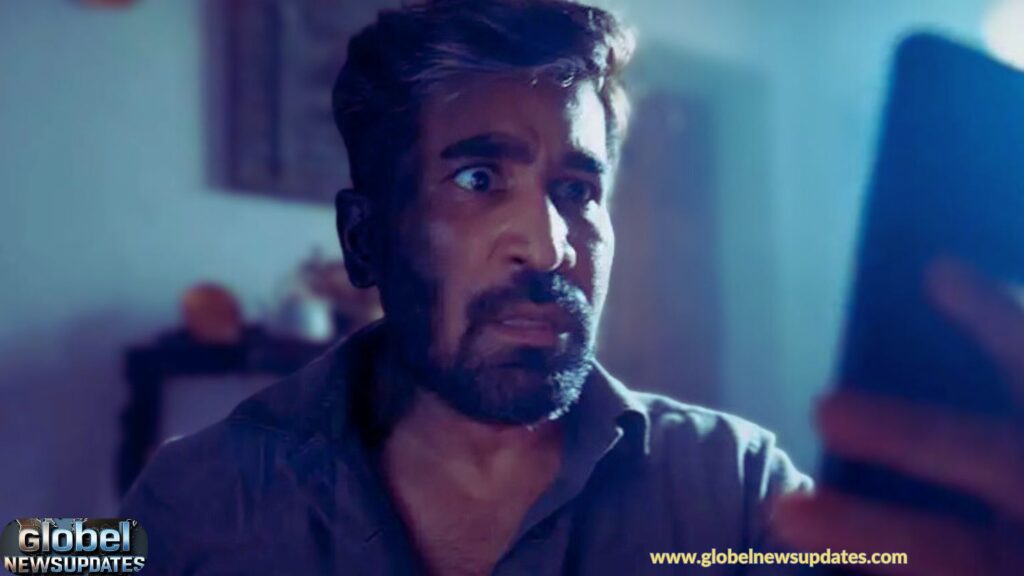Directed by Leo John Paul, ‘Morgan’ is an ambitious supernatural investigative thriller. The film confidently unveils its many strange ideas, but becomes somewhat dull with an instructive ending.
Editor-turned-director Leo John Paul’s ‘Margan’ is a strange genre mix. Theoretically, it might not work—if a film has an incomprehensible supernatural element, how much will the audience believe in the crime investigation?
Granted, we’ve seen detective stories revolving around monsters and mythical creatures. But the supernatural element in ‘Margan’ is rare. It’s a blend of artistry and weirdness. What’s interesting is how the story is emotionally constructed and actor-producer Vijay Antony is placed at its centre. Some of the unexpected ideas in the film may not make much sense outside the world of cinema.
For example, let’s look at the film’s key supernatural element. Actor Ajay Dishan plays the role of a young swimmer named Thamizarivu — and he impresses despite it being his debut. Not only is he gifted with eidetic memory, but he also has a unique “superpower”: he can enter and swim into the astral plane — that is, travel with his mind to a world beyond our physical world. It may sound a bit confusing, but it’s an extraordinary concept to hear.

Let’s imagine — what if you ate boring sambar rice in your office canteen yesterday, but didn’t notice the interesting dishes on the other side? If you had the powers of Tamizharivu, you would be able to go back in time, relive that reality at that time, and even go into the canteen kitchen through your astral body. But Tamizharivu’s mission in ‘Margan’ is not just about cooking — he has a much more serious goal.
Tamizharivu’s powers make him a suspect — a serial killer, injecting a mysterious drug into the bodies of young women, killing them instantly. The case is being investigated by Additional Director General of Police Dhruv Korak (Vijay Antony). He once came face to face with the murderer and was left with half of his body blackened. How would such a policeman investigate a case in which he himself was the victim?
This is where the real surprise begins. Despite all these unusual elements, Leo John Paul has managed to make this story interesting. The film keeps us interested with its attention right from the beginning. The story first shows Dhruv lying on the ground in his house in Mumbai. The darkness, the mysterious atmosphere, the camera angles showing his blackened body part — all this consistently strengthens the mood of the film.
Another interesting detail to note here — Dhruv has to open a message with his right hand to remove his left hand, because it is shown to be numb due to lack of sleep. These are the small, believable details that bring credibility to the film. Even though we see the supernatural aspect in small scenes like Dhruv ordering food and coffee for his team — Kaali (Mahanadhi Shankar), Shruti (Brigida Saga) — we can believe in Dhruv’s hunger and state of mind.
Notably, the interest in the storyline of ‘Margan’ starts there, till that point most thrillers have a story ending. Even though the suspect is already in custody, the real mystery comes to the fore only later. Unlike some recent Tamil thrillers, ‘Margan’’s story takes on a new significance after each scene — a button camera, a magazine cover, or a chlorine-filled water tank.
However, some logical flaws are bound to appear. Some important points are overlooked as the story progresses. For example, it may seem surprising that old acquaintances are not disturbed by the blackened part of Dhruv’s body. Also, the scenes revolving around Tamizharivu’s ex-girlfriend feel like they are not able to strengthen the story any further. On the other hand, one also wonders whether the police have to grieve personally in order to take a case seriously.
Ultimately, it is a great thing that ‘Margan’ has given its own internal logic to the supernatural and faithfully adhered to it. However, there are some flaws in the real-world logic. However, the film, the narrative style, the visuals, the background score, the range of colors — all of which come together to make it an interesting and emotional thriller.
Now, the main point that stands against this film is how the director has constructed the ending of the film and how it is understood by the audience. The director ends the story with a scene of chasing a duck sitting in the distance. Although it is in line with the story, one wonders if such an ending could have been told in a less didactic manner.

Morgan would have been better if it had remained a simple serial killer-investigative thriller. The supernatural element added at the end makes the weak reality of the film even more touching. Since some real-life elements related to the investigation in the story have been shown with a supernatural twist, the question arises whether the other elements in the climax could have been shown innovatively in the same manner. Although all the necessary ingredients are there, the director has failed to use them effectively.
Overall, the film Margan, in the vein of Tamil films – with characters that allow for artistic experimentation – has some things it can do, but it also fails to do so – especially in entertainingly reconciling the contradictions in narrative style and representation. Not every film needs to end with a moral lesson – and we can agree that it is enough if it is not explicitly stated what that lesson is.
